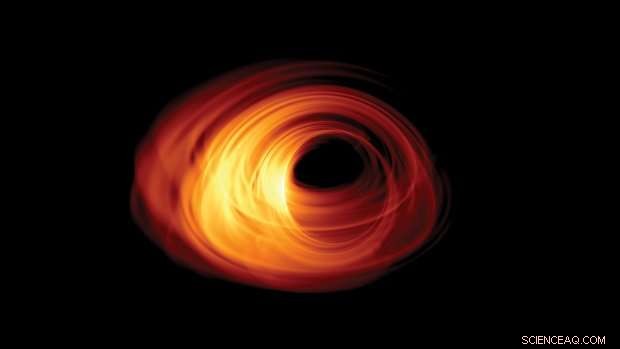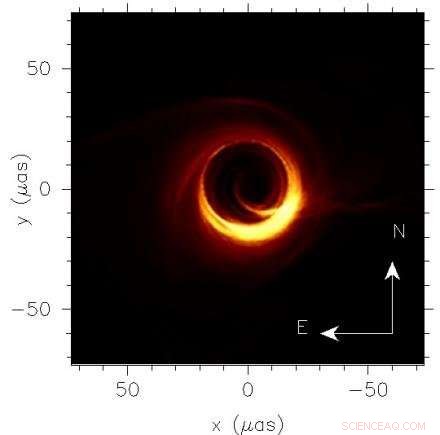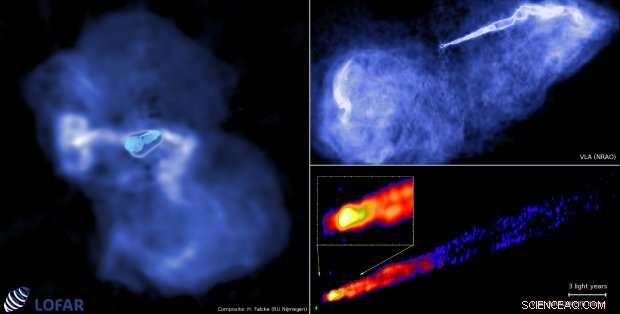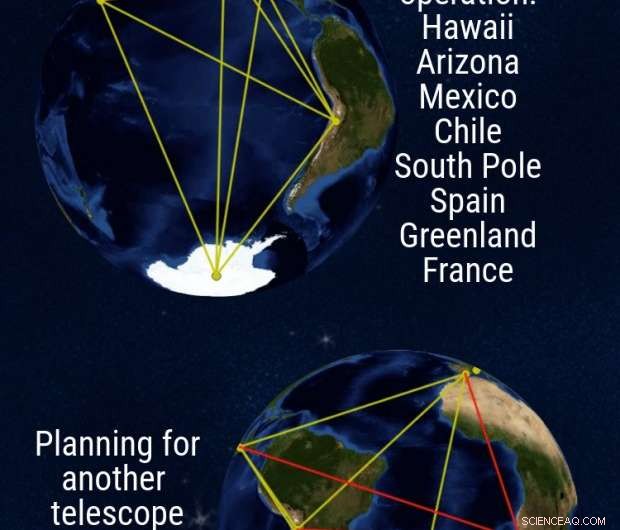
La sombra de un agujero negro rodeado por un anillo de fuego en una simulación genérica. Crédito:T. Bronzwaer, M. Moscibrodzka, Universidad H. Falcke Radboud
En las regiones sombrías de los agujeros negros chocan dos teorías fundamentales que describen nuestro mundo. ¿Pueden resolverse estos problemas y existen realmente los agujeros negros? Primero, es posible que tengamos que ver uno y los científicos están tratando de hacer precisamente esto.
De todas las fuerzas de la física hay una que todavía no entendemos en absoluto:la gravedad.
La gravedad es donde se encuentran la física fundamental y la astronomía, y donde las dos teorías más fundamentales que describen nuestro mundo, la teoría cuántica y la teoría del espacio-tiempo y la gravedad de Einstein (también conocida como la teoría de la relatividad general), chocan de frente.
Las dos teorías son aparentemente incompatibles. Y en su mayor parte, esto no es un problema. Ambos viven en mundos distintos, donde la física cuántica describe lo muy pequeño, y la relatividad general describe las escalas más grandes.
Solo cuando llegas a escalas muy pequeñas y gravedad extrema, ¿Chocan las dos teorías? y de alguna manera, uno de ellos se equivoca. Al menos en teoría.
Pero una vez hubo un lugar en el universo donde podríamos presenciar este problema en la vida real y quizás incluso resolverlo:el borde de un agujero negro. Aquí, encontramos la gravedad más extrema. Solo hay un problema:nadie ha 'visto' un agujero negro.
Entonces, ¿Qué es un agujero negro?
Imagina que todo el drama del mundo físico se desarrolla en el teatro del espacio-tiempo, pero la gravedad es la única "fuerza" que modifica realmente el teatro en el que actúa.
La fuerza de la gravedad gobierna el universo, pero puede que ni siquiera sea una fuerza en el sentido tradicional. Einstein lo describió como una consecuencia de la deformación del espacio-tiempo. Y quizás simplemente no se ajusta al modelo estándar de física de partículas.
Cuando una estrella muy grande explota al final de su vida, su parte más interna colapsará por su propia gravedad, dado que ya no hay suficiente combustible para sostener la presión trabajando contra la fuerza de la gravedad (sí, la gravedad se siente como una fuerza después de todo, ¿No es así?).
La materia colapsa y no se sabe que ninguna fuerza de la naturaleza pueda detener ese colapso, siempre.
En un tiempo infinito la estrella habrá colapsado en un punto infinitamente pequeño:una singularidad - o para darle otro nombre, un agujero negro.
Por supuesto, en un tiempo finito, el núcleo estelar se habrá derrumbado en algo de tamaño finito y esto todavía sería una gran cantidad de masa en una región increíblemente pequeña y ¡todavía se le llama agujero negro!
Los agujeros negros no succionan todo lo que los rodea
Curiosamente, no es cierto que un agujero negro atraiga inevitablemente todo.
De hecho, ya sea que esté orbitando una estrella o un agujero negro que se formó a partir de una estrella, no hace ninguna diferencia, siempre que la masa sea la misma. La vieja fuerza centrífuga y su momento angular lo mantendrán a salvo y evitarán que caiga.
Solo cuando disparas tus propulsores de cohetes gigantes para frenar tu rotación, ¿Empezarás a caer hacia dentro?
Sin embargo, una vez que caes hacia un agujero negro, serás acelerado a velocidades cada vez más altas, hasta que finalmente alcances la velocidad de la luz.

Imagen simulada como se predijo para el negro supermasivo en la galaxia M87 a las frecuencias observadas con el Event Horizon Telescope (230 GHz). Crédito:Moscibrodzka, Falcke, Shiokawa, Astronomía y Astrofísica, V. 586, pag. 15, 2016, reproducido con permiso © ESO
¿Por qué la teoría cuántica y la relatividad general son incompatibles?
En este punto, todo sale mal ya que, según la relatividad general, nada debería moverse más rápido que la velocidad de la luz.
La luz es el sustrato utilizado en el mundo cuántico para intercambiar fuerzas y transportar información en el mundo macro. La luz determina la rapidez con la que se pueden conectar causas y consecuencias.
Si vas más rápido que la luz podría ver los eventos y cambiar las cosas antes de que sucedan. Esto tiene dos consecuencias:
Si eso es cierto y si es necesario modificar la teoría de la gravedad (o de la física cuántica), y cómo, es una cuestión de intenso debate entre los físicos. y ninguno de nosotros puede decir en qué dirección conducirá el argumento al final.
¿Existen siquiera los agujeros negros?
Por supuesto, toda esta emoción solo estaría justificada, si los agujeros negros realmente existieran en este universo. Entonces, ¿ellos?
En el último siglo se ha acumulado una fuerte evidencia de que ciertas estrellas binarias con intensas emisiones de rayos X son de hecho estrellas colapsadas en agujeros negros.
Es más, en los centros de las galaxias, a menudo encontramos evidencia de enormes, concentraciones oscuras de masa. Estas podrían ser versiones supermasivas de agujeros negros, posiblemente formado por la fusión de muchas estrellas y nubes de gas que se han hundido en el centro de una galaxia.
La evidencia es convincente pero circunstancial. Al menos las ondas gravitacionales nos han permitido 'escuchar' la fusión de los agujeros negros, pero la firma del horizonte de sucesos sigue siendo esquiva y, hasta ahora, en realidad nunca hemos 'visto' un agujero negro; simplemente tienden a ser demasiado pequeños y demasiado lejos y, en la mayoría de los casos, sí, negro...
Entonces, ¿Cómo se vería realmente un agujero negro?
Si pudieras mirar directamente a un agujero negro, verías la oscuridad más oscura, puedes imaginar.
Pero, el entorno inmediato de un agujero negro podría ser brillante a medida que los gases se desplazan en espiral hacia adentro, ralentizados por el arrastre de los campos magnéticos que transportan.
Debido a la fricción magnética, el gas se calentará a temperaturas enormes de hasta varias decenas de miles de millones de grados y comenzará a irradiar luz ultravioleta y rayos X.
Los electrones ultra calientes que interactúan con el campo magnético en el gas comenzarán a producir una intensa emisión de radio. Por lo tanto, los agujeros negros pueden brillar y estar rodeados por un anillo de fuego que irradia en muchas longitudes de onda diferentes.
Un anillo de fuego con una oscuridad centro oscuro
En su mismo centro, sin embargo, el horizonte de sucesos todavía acecha y, como un ave de presa, atrapa cada fotón que se acerca demasiado.

Radio images of the jet in the radio galaxy M87 – observed at lower resolution. The left frame is roughly 250, 000 light years across. Magnetic fields threading the supermassive black holes lead to the formation of a highly collimated jet that spits out hot plasma with speeds close to the speed of light . Credit:H. Falcke, Radboud university, with images from LOFAR/NRAO/MPIfR Bonn
Since space is bent by the enormous mass of a black hole, light paths will also be bent and even form into almost concentric circles around the black hole, like serpentines around a deep valley. This effect of circling light was calculated already in 1916 by the famous Mathematician David Hilbert only a few months after Albert Einstein finalised his theory of general relativity.
After orbiting the black hole multiple times, some of the light rays might escape while others will end up in the event horizon. Along this complicated light path, you can literally look into the black hole. The nothingness you see is the event horizon.
If you were to take a photo of a black hole, what you would see would be akin to a dark shadow in the middle of a glowing fog of light. Por eso, we called this feature the shadow of a black hole .
Curiosamente, the shadow appears larger than you might expect by simply taking the diameter of the event horizon. The reason is simply, that the black hole acts as a giant lens, amplifying itself.
Surrounding the shadow will be a thin 'photon ring' due to light circling the black hole almost forever. Further out, you would see more rings of light that arise from near the event horizon, but tend to be concentrated around the black hole shadow due to the lensing effect.
Fantasy or reality?
Is this pure fantasy that can only be simulated in a computer? Or can it actually be seen in practice? The answer is that it probably can.
There are two relatively nearby supermassive black holes in the universe which are so large and close, that their shadows could be resolved with modern technology.
These are the black holes in the center of our own Milky Way at a distance of 26, 000 lightyears with a mass of 4 million times the mass of the sun, and the black hole in the giant elliptical galaxy M87 (Messier 87) with a mass of 3 to 6 billion solar masses.
M87 is a thousand times further away, but also a thousand times more massive and a thousand times larger, so that both objects are expected to have roughly the same shadow diameter projected onto the sky.
Like seeing a grain of mustard in New York from Europe
Coincidentally, simple theories of radiation also predict that for both objects the emission generated near the event horizon would be emitted at the same radio frequencies of 230 GHz and above.
Most of us come across these frequencies only when we have to pass through a modern airport scanner but some black holes are continuously bathed in them.
The radiation has a very short wavelength of about one millimetre and is easily absorbed by water. For a telescope to observe cosmic millimetre waves it will therefore have to be placed high up, on a dry mountain, to avoid absorption of the radiation in the Earth's troposphere.
Effectively, you need a millimetre-wave telescope that can see an object the size of a mustard seed in New York from as far away as Nijmegen in the Netherlands. That is a telescope a thousand times sharper than the Hubble Space Telescope and for millimetre-waves this requires a telescope the size of the Atlantic Ocean or larger.
A virtual Earth-sized telescope
Afortunadamente, we do not need to cover the Earth with a single radio dish, but we can build a virtual telescope with the same resolution by combining data from telescopes on different mountains across the Earth.
The technique is called Earth rotation synthesis and very long baseline interferometry (VLBI). The idea is old and has been tested for decades already, but it is only now possible at high radio frequencies.

Layout of the Event Horizon Telescope connecting radio telescopes around the world (JCMT &SMA in Hawaii, AMTO in Arizona, LMT in Mexico, ALMA &APEX in Chile, SPT on the South Pole, IRAM 30m in Spain). The red lines are to a proposed telescope on the Gamsberg in Namibia that is still being planned. Credit:ScienceNordic / Forskerzonen. Compiled from images provided by the author
The first successful experiments have already shown that event horizon structures can be probed at these frequencies. Now high-bandwidth digital equipment and large telescopes are available to do this experiment on a large scale.
Work is already underway
I am one of the three Principal Investigators of the BlackHoleCam project. BlackHoleCam is an EU-funded project to finally image, measure and understand astrophysical black holes. Our European project is part of a global collaboration known as the Event Horizon Telescope consortium – a collaboration of over 200 scientists from Europe, the Americas, Asia, y Africa. Together we want to take the first picture of a black hole.
In April 2017 we observed the Galactic Center and M87 with eight telescopes on six different mountains in Spain, Arizona, Hawai, México, Chile, and the South Pole.
All telescopes were equipped with precise atomic clocks to accurately synchronise their data. We recorded multiple petabytes of raw data, thanks to surprisingly good weather conditions around the globe at the time.
We are all excited about working with this data. Of course, even in the best of all cases, the images will never look as pretty as the computer simulations. Pero, at least they will be real and whatever we see will be interesting in its own right.
To get even better images telescopes in Greenland and France are being added. Es más, we have started raising funds for additional telescopes in Africa and perhaps elsewhere and we are even thinking about telescopes in space.
A 'photo' of a black hole
If we actually succeed in seeing an event horizon, we will know that the problems we have in rhyming quantum theory and general relativity are not abstract problems, but are very real. And we can point to them in the very real shadowy regions of black holes in a clearly marked region of our universe.
This is perhaps also the place where these problems will eventually be solved.
We could do this by obtaining sharper images of the shadow, or maybe by tracing stars and pulsars as they orbit around black holes, through measuring spacetime ripples as black holes merge, or as is most likely, by using all of the techniques that we now have, juntos, to probe black holes.
A once exotic concept is now a real working laboratory
Como estudiante, I wondered what to study:particle physics or astrophysics? After reading many popular science articles, my impression was that particle physics had already reached its peak. This field had established an impressive standard model and was able to explain most of the forces and the particles governing our world.
Astronomy though, had just started to explore the depths of a fascinating universe. There was still a lot to be discovered. And I wanted to discover something.
En el final, I chose astrophysics as I wanted to understand gravity. And since you find the most extreme gravity near black holes, I decided to stay as close to them as possible.
Hoy dia, what used to be an exotic concept when I started my studies, promises to become a very real and very much visible physics laboratory in the not too distant future.
Esta historia se vuelve a publicar por cortesía de ScienceNordic, la fuente confiable de noticias científicas en inglés de los países nórdicos. Lea la historia original aquí.